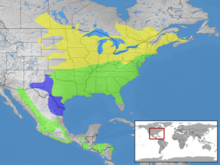Eastern bluebird
| Eastern bluebird | |
|---|---|
 |
|
| Pair in Michigan | |
| Scientific classification | |
| Kingdom: | Animalia |
| Phylum: | Chordata |
| Class: | Aves |
| Order: | Passeriformes |
| Family: | Turdidae |
| Genus: | Sialia |
| Species: | S. sialis |
| Binomial name | |
|
Sialia sialis (Linnaeus, 1758) |
|
 |
|
| Geographic distribution of S. sialis Breeding range Year-round range Wintering range | |
The eastern bluebird (Sialia sialis) is a small thrush found in open woodlands, farmlands, and orchards. It is the state bird of Missouri and New York.
This species measures 16–21 cm (6.3–8.3 in) long, spans 25–32 cm (9.8–12.6 in) across the wings, and weighs 27–34 g (0.95–1.20 oz). Eastern bluebirds are found east of the Rockies, southern Canada to the Gulf states, and southeastern Arizona to Nicaragua. The increase in trees throughout the Great Plains during the past century due to fire suppression and tree planting facilitated the western range expansion of the eastern bluebird as well as range expansions of many other species of birds.
The bright-blue breeding plumage of the male, easily observed on a wire or open perch, makes this species a favorite of birders. The male's call includes sometimes soft warbles of 'jeew' or 'chir-wi' or the melodious song 'chiti WEEW wewidoo'.
About two-thirds of the diet of an adult consists of insects and other invertebrates. The remainder of the bird's diet is made up of wild fruits or berries. Favored insect foods include grasshoppers, crickets, katydids, and beetles. Other food items include earthworms, spiders, millipedes, centipedes, sow bugs, and snails.
Fruits are especially important when insects are scarce in the winter. Some preferred winter food sources include dogwood, hawthorn, wild grape, and sumac, and hackberry seeds. Supplemental fruits eaten include black raspberries, bayberries, fruit of honeysuckle, Virginia creeper, eastern juniper, and pokeberries. Bluebirds feed by perching on a high point, such as a branch or fence post, and swooping down to catch insects on or near the ground. The availability of a winter food source will often determine whether or not a bird will migrate. If bluebirds do remain in a region for the winter, they group and seek cover in heavy thickets, orchards, or other areas in which adequate food and cover resources are available.
...
Wikipedia

